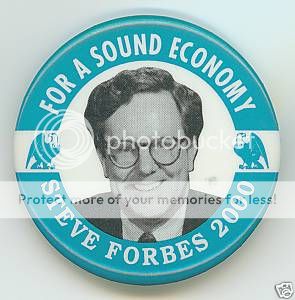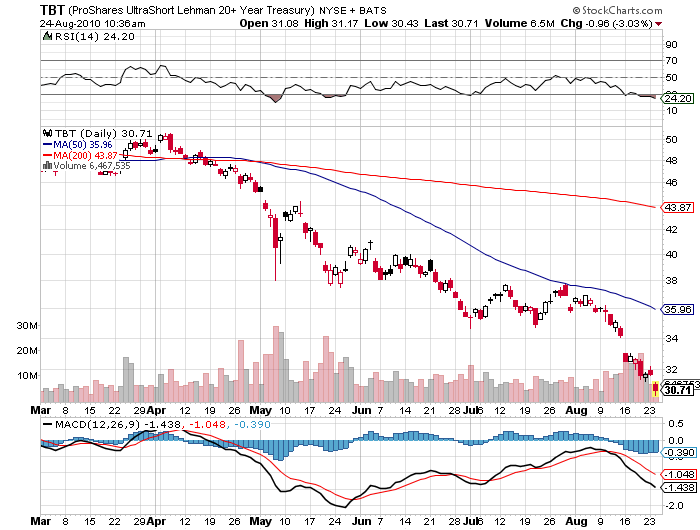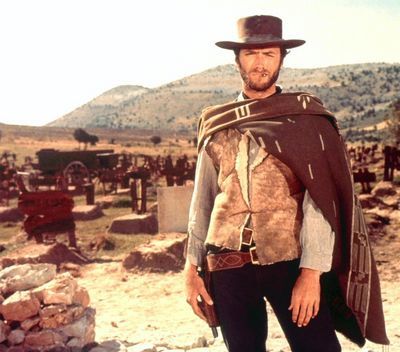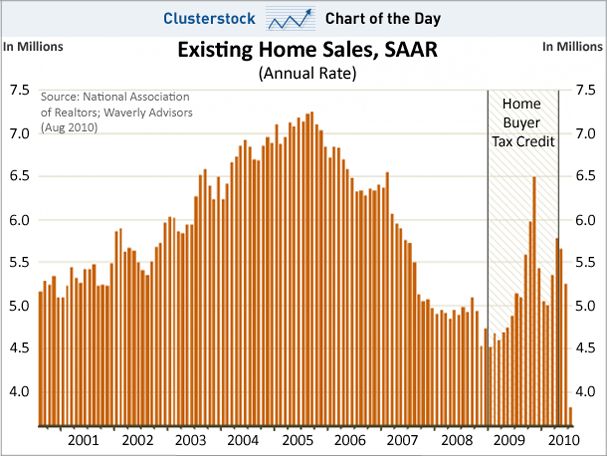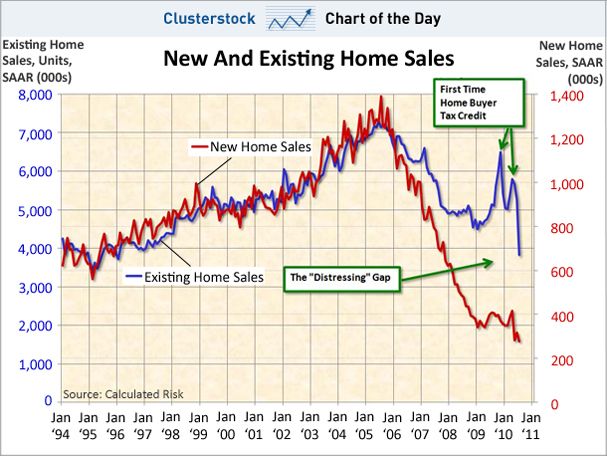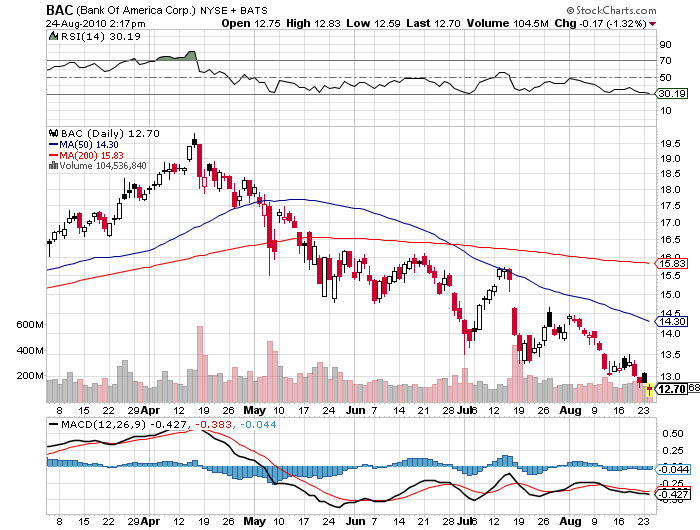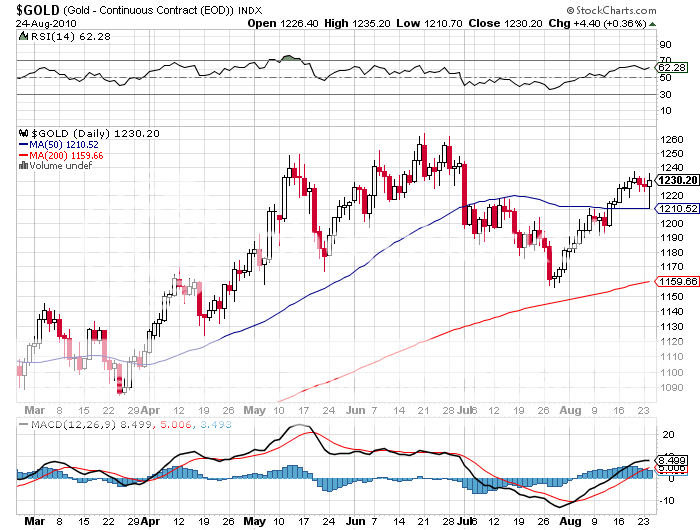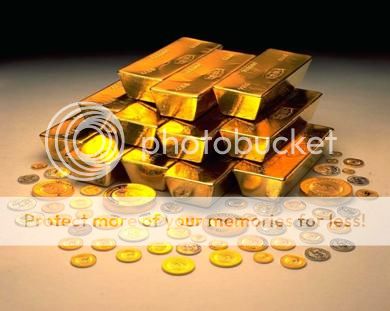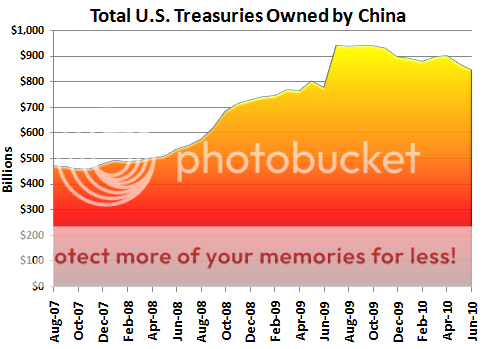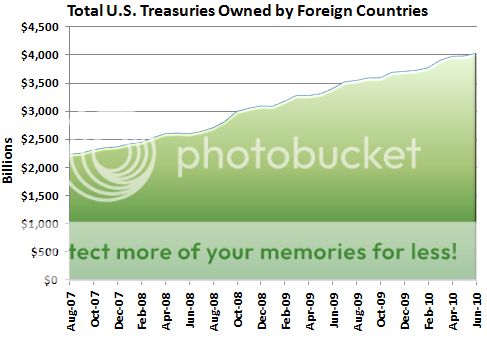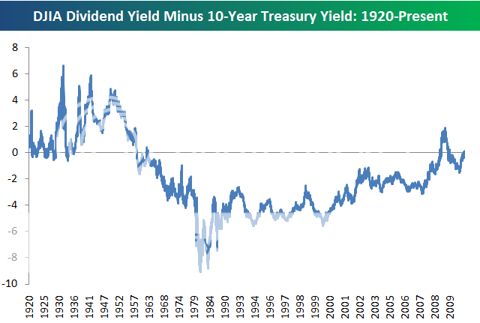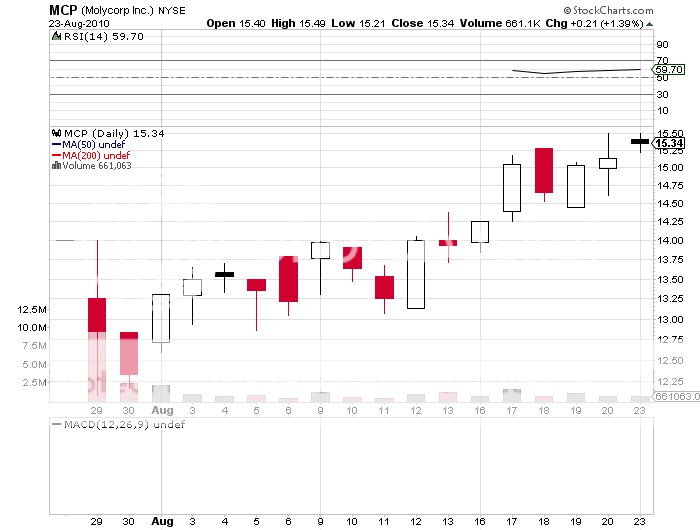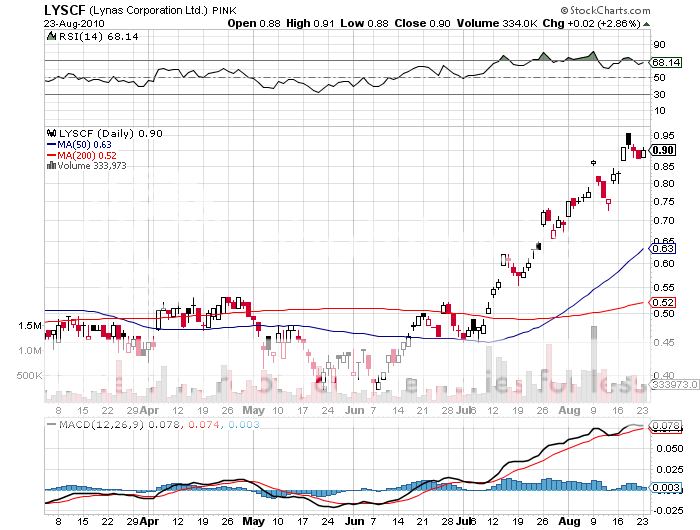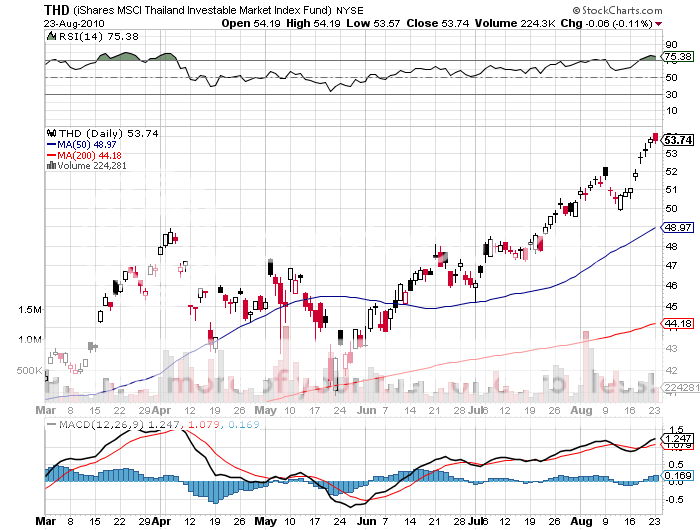
Featured Trades: (GOLD), (GLD), (GDX)
SPDR Gold Shares ETF
Market Vectors Gold Miners ETF
1) The San Francisco Money Show. I attended the Woodstock of investment conferences last week, the San Francisco Money Show, which offered an entertaining three ring circus of traders, foreign exchange models, options platforms, newsletters, cruises, video broadcasts, and more.
The cavernous Marriott Marquis hotel and convention center South of Market on 4th Street was absolutely bubbling with new ideas. You couldn't walk five feet without tripping over a great investment theme, and information overload was the problem of the day. There was a plethora of celebrity speakers, including Elaine Garzarelli, John Mauldin, and Think or Swim founder, Tom Sosnoff.
There really is no corner of the financial markets that was not well represented by market makers, analysts, technology providers, and investors-- thousands of them. With the soaring level of US government debt scaring the daylights out of everyone, the precious metals dealers were there in force.
Of course, the hard asset crowd was everywhere, and you could not swing a dead cat without hitting a miner looking for new funding. Never mind that the barbaric relic went up for all the wrong reasons. The dollars they're making are still just as good at the bar. The only thing missing from the show was the long predicted hyper inflation. Want to prospect in the Ivory Coast? No problem.
I was pleasantly surprised by the diversity of major corporate sponsors there to promote their own shares, like Darden Restaurants, Proctor and Gamble, Roche, Sanofi Aventis, Vale, and Nidec, several of which are great investments. A variety of oil service companies were also well represented. A 'green' section offered a look at wind, solar, and geothermal energy providers.
I took the opportunity to talk with companies about everything from the latest drilling costs, long term food prices, and the true cost of geothermal, to the clever play in gold coins (go for those struck at the San Francisco Mint). I was constantly amused every few minutes by attendees who, seeing my nametag, asked to have a photo taken with the one and only Mad Hedge Fund Trader, and to sign their program.
After I make my fortune, there was even a booth extolling the virtues of retiring on the beach in Costa Rica or Belize. It was a great opportunity to chat with the end investors who ultimately drive all these markets. All in all, it was a weekend well invested. For a calendar of future events, go to www.MoneyShow.com.
Featured Trades: (STEVE FORBES)
2) A Chat With Steve Forbes. I sat down with Forbes magazine publisher and perennial Republican presidential candidate, Steve Forbes, whose father, Malcolm, I knew from my journalism days in the seventies. He was there formally to promote his new book, Power Ambition Glory, but I couldn't help but sense his loftier goals.
He says that the crash was a failure of government. It was caused by the Fed, which pursued a weak dollar policy, kept interest rates too low for too long, and printed too much money. Our central bank should pursue a strong dollar policy which will bring a revival of the credit markets. We have the most hard left president and congress in history, and they are on the cusp of getting what they want. Lifting the rules on upticks and naked shorting threw gasoline on the fire.
The rating agencies are a cartel we should get rid of. Let the free markets work. The stock market recovery last year came with the modification of mark-to-market rules, which never should have been in force. George Bush betrayed the Republican party by abandoning its principles.
Steve has always championed the libertarian wing of his party, and has been the leading proponent of the flat income tax. Did I just hear the first campaign speech of the 2012 presidential election?
SPECIAL BOND BUBBLE ISSUE
Featured Trades: (TREASURY BONDS), (TIPS), (TBT)
ProShares Ultra Short 20 year +Treasury ETF
1) Don't Buy That Treasury Bond. Another week later, and Treasury bond prices have raced up to even dizzier heights, breaking more records for over valuation. According to the Investment Company Institute, outflows from equity mutual funds over the last two years totaled $232 billion, while inflows into bond funds soared to a staggering $559 billion. Today, 'bond funds' ranked with 'Miss Universe' and 'Lindsey Lohan' among Yahoo's top ten search terms. Companies, like FedEx, are looking to issue corporate bonds maturing in 100 years. No doubt the prospect of 80 million baby boomers bailing on equities so they can become coupon clippers for life is providing some extra juice for this market.
In a Wall Street Journal article last week, the Wharton School's Jeremy Siegel pointed out that ten year inflation protected securities (TIPS) with yields under 1% are selling at a PE multiple equivalent of 100 times, the same valuation that dotcom stocks saw a decade ago (click here). Bonds with four year maturities have negative real yields.
The last time this happened, in 1955, ten year bonds brought in an annual return of only 1.9% for the following decade. The potential capital losses for these securities now loom large. In the meantime, the short Treasury ETF (TBT) trades at $30.60.
Let me run some numbers here. If the yield on the 30 year Treasury bond runs up to last year's low of 3%, the TBT will fall to a new all time low of $27. If I'm right, and we move back up to the 2010 high of 5.05%, the TBT pops back to $51.50. Running a downside risk of 11% to capture a potential gain of 68% sounds like a pretty good risk/reward ratio to me. But it might get better. Don't forget that my long term, multi year target for this ETF is $200.
If the futures players get this right, a move in the December long bond (ZBZ0) on the CBOT from today's high of 134.5 to this year's low of 111.50 multiplies your minimum margin requirement from $3,375 to $23,000, a 6.8 fold return.
But wait, there's more! If you don't feel like making big bets until you figure out what the new normal looks like, try a limited risk position through the TBT options. The March $30 strike calls are trading at $4. A run up by the ETF to this year's high puts these babies at $21 at expiration, a net profit of $17, a gain of 425%.
I'll tell you some key targets to watch for to determine the timing on this: when the yen approaches ?80, the S&P 500 touches 950, the 30 year yield tickles 3%, and the ten year yield slams into 2%, it will all be over but the crying. I'm still keeping my powder dry for taking another shot at this trade, but my trigger finger is getting mighty itchy.
Getting an Itchy Trigger Finger for the TBT
Not as Popular as a Bond Fund?
SPECIAL BOND BUBBLE ISSUE
Featured Trades: (RESIDENTIAL REAL ESTATE), (BAC)
2) Another Nail in the Coffin for Residential Real Estate. Those few, like myself, who believe that the residential real estate market has another down leg ahead of it, got their smoking gun yesterday. July existing home sales cratered 27.2% to a seasonally adjusted rate of 3.83 million units, the sharpest month to month drop in history, and the lowest sales pace since 1995. YOY sales are off 25.5%, and the June figures were also revised down. Inventories are now at a 12.5 month supply, the highest on record.
Low end buyers totally bailed on the market. It looks like the baby boomer effect is hitting the market big time, as I have been detailing in my endless posts on the subject (click here for 'The Hard Truth About Residential Real Estate'). It is also now screamingly obvious that the net effect of the $8,000 first time home buyers tax credit and similar, complimentary efforts by the states has been to pull forward purchases of homes, not create new demand. Like this was ever in doubt?
I can tell you one thing for sure. Bank share prices have not yet discounted weaker home prices, and the bleeding collateral this implies. The 36% decline that Bank of America's (BAC) shares have suffered since April may not be enough. Again, rent, don't buy, unless you plan on living there for ten years, and don't mind giving up your first born child for collateral.
SPECIAL BOND BUBBLE ISSUE
Featured Trades: (GOLD), (GLD), (GDX)
SPDR Gold Shares ETF
Market Vectors Gold Miners ETF
3) Why Gold Seems Unbreakable. While the rest of the world has been going to hell in a hand basket, gold (GLD), (GDX) refuses to take a serious dip, and is threatening the old $1,260 high. Today, the World Gold Council, the ultimate go-to source for figures on global supply and demand for the barbaric relic, published its 2010 Q2 assessment yesterday. The report paints a positively bullish outlook for the yellow metal (click here for the link at http://www.gold.org/).
Investment demand has been skyrocketing, causing total buying to jump 36% to 1,050 metric tonnes YOY. Purchases from the new exchange traded funds have soared 414% to 291 tonnes. Hoarding of gold bars, primarily in emerging markets, is up 29% to 96 tonnes. India and China will continue to be the new demand driver for the foreseeable future.
A flight to safety bid from Europeans desperate for a hard alternative to the Euro has been strong. A recovering economy has caused industrial electronics gold consumption, especially from Japan, to jump 14% to 107 tonnes, near all time highs. Substantially higher prices caused jewelry demand to fall 5% to 408 tonnes, driven by a pull back in buying from India.
I'm starting to wonder if my long term target of $2,300/ounce is too conservative (click here for 'What to do About Gold'). Overall, it is one of the most positive reports I can recall. Gold bugs should print it out so they can sleep with it under their pillows at night.
Sleeping Better With Gold Coins Under Your Pillow
SPECIAL BOND BUBBLE ISSUE
Featured Trades: (TREASURY BONDS)
4) Its Official: China is Unloading its Treasury Bonds. It looks like the smart money these days is found in China. While American investors have been scrambling over each other to buy more Treasury bonds at historically low yields, China has begun quietly unloading some of its own enormous holdings. In June, the Middle Kingdom sold $21.2 billion of?? paper, reducing its net long to $839.7 billion. This is little more than 10% of the total $8.18 trillion in federal debt that Uncle Sam has outstanding.
Total foreign ownership of US Treasury bonds amounts to $4 trillion, up from $2.4 trillion in three years.?? Instead, the Chinese have been buying Japanese government bonds, which today carry a paltry 0.9% yield, but have the merit that they are denominated in a rapidly appreciating currency. The Mandarins in Beijing have also been picking up a variety of bonds in Europe which have seen yields pushed to near records, thanks to the debt crisis there.
Officials at the People's Bank of China say that it is all part of a broader diversification effort away from the greenback. PIMCO's Bill Gross has apparently been taking Mandarin lessons on the sly because he has also been paring back his own massive holdings in longer dated Treasuries. To understand why, take a look at the chart below of the spread between the Dow dividend yield and the ten year Treasury yield which has turned positive for the first time since 1955.
China Can't Unload Those Treasury Bonds Fast Enough
'If you look at previous times in US history when bond yields were this low, the returns have been quite poor. Bonds now have many elements of a bubble. We're at the end of the debt super cycle. First we had a large banking crisis. The next step is a large sovereign crisis. This means that government bonds are a pretty bad bet over a five to ten year period,' said Jonathan Tepper, partner and chief editor of Variant Perception, an economic research boutique.
Featured Trades: (BEHAVIORAL TARGETING)
1) So You Think They're Not Watching You on Your PC? Hey! You there, staring at this monitor. This is your PC talking to you. No, not you over there standing in the background. I'm talking to the guy sitting in front of me poking at my keys. Ouch! That one hurt!
So you thought no one was watching, did you? Let me straighten you out. About a month ago you clicked on a certain website, and I installed myself as a cookie on your computer, which is an innocuous little text file that you can't see. Since then, I have been tracking your every move, recording websites you clicked on, the pages you visited, and the stuff you ordered. I then used this handy little algorithm to build a profile of exactly who you are. I now know you better than your own mother. In fact, I know you better than you know yourself.
For example, I am aware that you make more than $250,000 a year, live in a posh zip code in San Francisco, belong to a fancy country club, and drive a Mercedes. You donate to Republican political causes, send your kids to a prestigious private school, and bill it all to an American Express Platinum Card. Did I leave anything out?
Because I know every detail of your life, down to your inside leg measurement, I am able to harness the power of this machine to more precisely service your every need. That includes directing advertising to you, which you have a high probability of clicking on. The more you click on my ads, the higher prices I can realize for those ads. The ad campaigns you now see are unique to your own personal computer because they are tied to your IP address. My program, called 'behavioral targeting' is the next 'big thing' in online advertising. It's all part of the brave new world.
I see you have been shopping for a new car. Check out the new Hyundai at http://www.hyundaiusa.com/ , which offers the same quality as your existing ride, at half the price. Your clicks this morning suggest you're taking your 'significant other' out to dinner tonight. Might I suggest Gary Danko's on Bay Street at http://www.garydanko.com/site/bio.html ? The rack of lamb is to die for there. Your visits to http://www.travelocity.com/ and http://www.expedia.com/ tell me you're planning a vacation. I bet you didn't know you can find incredible deals in Las Vegas at http://www.visitlasvegas.com/vegas/index.jsp . Thinking about buying a condo there? They'll even pay for the trip if you promise to check one out while you're there.
Since we're chatting here mano a mano, I noticed that that last pair of jeans you ordered from http://us.levi.com/home/index.jsp had a 42-inch waist, up from the 40's in your last order. Better lay off those cheeseburgers. Pretty soon, they'll be calling you 'tubby' or 'fatso'. Better visit http://www.weightwatchers.com/Index.aspx soon, or the legs on that chair might buckle out from under you.
Worried about privacy? Privacy, shmivacy. There hasn't been privacy in this country since the first social security number was handed out in 1936. And don't expect any relief from Congress. I doubt half those dummies even know how to turn on their own PC's.
Don't even think about trying to delete me. I'm a 'flash cookie', an insidious little piece of code that reinstalls every time you try that. Think of me as a toenail fungus. Once you catch me, I'm almost impossible to get rid of.
I hope you don't mind, but I've been passing your personal details around to some of my buddies at other websites. That's why when you clicked on http://www.nfl.com/ you got deluged with product offers from your local team, the San Francisco 49ers.?? I've got friends at Google, Facebook, MySpace, and pretty much everywhere. Can I help it if I'm a popular guy? I bet the view from those 50 yard seats is great, isn't it?
I noticed that your spending habits don't exactly match with the income you reported on your last tax return. Do you think the IRS would like to know about that? I bet you didn't know the agency offers a 10% reward for turning in tax cheats.
How did you like those triple X DVD's you bought last week? Whoa! Hot, hot, hot! I hope your employer never finds out about those. It might not go down too well at your next performance review.
I thought it was lovely that you bought your spouse a two carat, yellow, vvs1, round cut diamond ring for $26,000 from http://www.bluenile.com/ for your 30th wedding anniversary. But who is Lolita, the Argentine firecracker, in Miami Beach? Does the old wifey know you sent her a $2,000 pair of diamond stud earrings? What's it worth to you for me to keep mum on this? Maybe you should take a quick peak at http://www.divorcelawfirms.com/ and see what you're in for?
Naw, I'm just pulling your leg. This is all just between friends, right? Think of it as a doctor/patient relationship. I'll tell you what. See that leaderboard ad at the top of the page? Just click on that and we'll call it even. Oooh that felt good! Click it again. Oh, baby! Not too many times. You'll trigger my anti click fraud program.
Now you see that wide skyscraper add over on the right? Click on that too. Oh baby! Click it again! And there's a little button ad at the bottom of the page. No, not that one. A little lower. What was that little cutie's name in Miami again? Aaaaah.
Featured Trades: (RARE EARTHS), (MCB), (LYSCF)
2) It's Off to the Races at Molycorp. I just wanted to follow up on the rare earths piece which I recently published (click here for "Rare Earths Are Becoming A Lot More Rare"). Despite lackluster market conditions at best, Molycorp (MCP) managed to raise $394 million through its July IPO at $14/share. The company will use the funds to reopen a rare earths mine at Mountain Pass, California, making it the largest such producer in the world outside of China. The company will start production by the end of the year, and go full scale by 2012.
This is important because China, supplier of 97% of the world's supply of rare earths, has cut back export quotas by 40% this year. These incredibly expensive metals are crucial for the manufacture of a variety of alternative energy hardware, as well as a number of military applications. Since the launch, the stock has risen 11%, making it one of the best performing stocks in the market this summer.
So far, the Australian miner Lynas Corp (LYSCF) has been the big beneficiary of the stampede into rare earths shares, doubling since I first recommended it in May (click here for the call). Lynas offers established production and experienced management, higher grade ore with a 9.7% yield, higher levels of the more valuable rare earths, realizations per ton that are 57% higher, and a book value of 1.87.
MCP is expected to have a 8.24% yield, is easier to trade with a US listing, has better liquidity, and prospects of greater profitability down the road through vertical integration and economies of scale, at the price of a 2.61 book value. MCP may also receive a political boost in the fall if a group of 20 senators and congressmen are successful in getting the Department of Energy to provide $280 million in loan guarantees. Look at these companies as an alternative energy, national defense, commodity play, a win-win-win.
There's Cerium in Them Thar Hills
Featured Trades: (THD), (TF), (F), (NSANY), (TM)
iShares MSCI Thailand Investable Market Index ETF
Thai Capital Fund
3) Thailand Punches Through to New Highs. With hotel occupancy in the dumps at 20%-30%, and parts of downtown Bangkok still in ruins from the May riots, you would think the call to buy Thailand (THD), (TF) two months ago was a complete bust (click here for the piece).
You would be wrong. Since then, the Thai ETF has tacked on an amazing 20%, the Thai Capital Fund is up 24%, and the Thai Baht has strengthened, making it one of the top performing stock markets of 2010. Even with the collapse of tourism, GDP is expected to come in at a healthy 6% this year, a figure American economists would kill for.
The country's robust manufacturing sector, which accounts for 66% of Thai GDP, versus only 6% for tourism, continues to drive the country onward and upward. Think of Thailand as China, with the infrastructure already built out. Ford Motors (F) has announced the construction of a $450 million plant to build the Focus, while Nissan (NSANY) says it will assemble its compact. Toyota (TM) and GM are expected to follow suit with the expansion of existing facilities.
Carl Van Horne, then the chief investment officer of JP Morgan, once taught me a rule that I have found incredibly useful: follow the direct investment; the stocks markets always play catch up. Thailand continues to be a place where international investors want to be. Buy on dips, if we get any.



